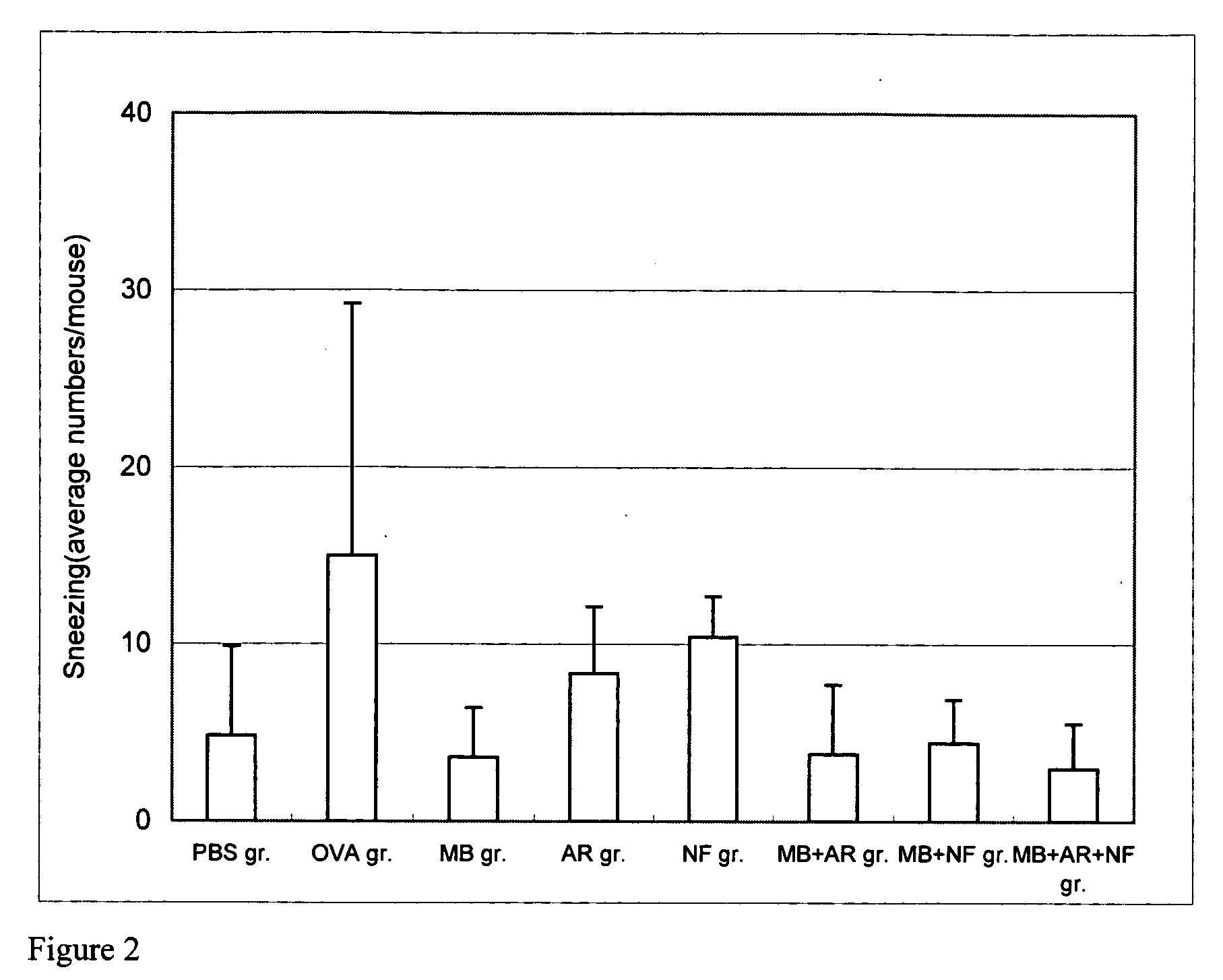Essential oils for treating and/ or preventing allergic disease
a technology of essential oils and allergies, applied in the direction of immunological disorders, drug compositions, biocides, etc., can solve the problems of unsatisfactory allergic symptoms and achieve the effect of preventing allergic diseases
- Summary
- Abstract
- Description
- Claims
- Application Information
AI Technical Summary
Benefits of technology
Problems solved by technology
Method used
Image
Examples
example
Example 1
Inhibitory Effect of Essential Oils on NO Production by LPS-Activated Mouse Macrophage Cell Line RAW 246.7
A) Cell Culture
[0032] The mouse macrophage cell line RAW 264.7 was purchased from Bioresources Collection & Research Center, Taiwan and numbered CCRC 60001. The cells were added to Dulbecco's Modified Eagle Medium (DMEM, GibcoBRL) containing 10% (v / v) fetal bovine serum (FBS, GibcoBRL) and then incubated in a CO2 incubator containing 5% CO2 at 37° C. The cells grow to 90% density and are then washed with phosphate buffered saline (PBS). The cells were colleted and diluted with fresh DMEM to the appropriate concentration.
B) Determination of Production of Nitric Oxide
[0033] The mouse macrophage cells were transferred in a 96-well plate in a concentration of 10,000 cells / well. After incubating for 24 hours, the cells were activated with the medium containing 100 μg / ml Lipopolysaccharide (LPS, SIGMA) and 100·μg / ml Interferon-γ (INF-γ, GibcoBRL). Meanwhile, the essent...
example 2
Inhibitory Activity of Essential Oils on PAF-Induced Platelet Aggregation
A) Preparation of Platelet Suspension
[0035] The anticoagulant “acid-citrate-dextrose” (ACD) was added to the blood taken from a New Zealand rabbit in a ratio of 1:6 by volume. The resulting blood was centrifuged at 190 g for 15 min at room temperature. After centrifugation, the supernatant containing platelet-rich plasma (PRP) was taken and 0.2 M EDTA was added. The resulting supernatant was centrifuged at 1000 g for 1.5 min. After centrifugation, the pellet containing RBC and WBC was removed and then PRP was centrifuged at 1000 g for 11 min. After centrifugation, the supernatant was removed and the platelet pellet was suspended in Ca2+--free Tyrode's buffer (containing 1 mM Ca2+). The platelet was added apyrase and cultured for 15 min at 37° C., and then added EDTA (final concentration was 5 mM) and centrifuged at 1000 g for 6 min. After centrifugation, the platelet pellet was resuspended in Ca2+-Tyrode's b...
example 3
In Vivo Assay of Essential Oils from Herbs of the Present Invention
[0038] Fifty-six male, 8-10 weeks old, Balb / c mice, purchased from the National Laboratory Animal Breeding and Research Center, Taipei, Taiwan, were used in this example. The mice were randomly divided into 8 groups (7 mice / group). Each group was treated by different process listed as follows: [0039] I) PBS group: The mice were sensitized by intraperitioneal injection and challenged by intranasal challenge with PBS. [0040] II) OVA group: The mice were sensitized by intraperitioneal injection and challenged by intranasal challenge with OVA. [0041] III) Essential oil of Magnolia biondii group (MB group): The mice were sensitized by intraperitioneal injection and challenged by intranasal challenge with OVA and then treated with essential oil of Magnolia biondii. [0042] IV) Essential oil of Agastche rugosa group (AR group): The mice were sensitized by intraperitioneal injection and challenged by intranasal challenge wit...
PUM
 Login to View More
Login to View More Abstract
Description
Claims
Application Information
 Login to View More
Login to View More - R&D
- Intellectual Property
- Life Sciences
- Materials
- Tech Scout
- Unparalleled Data Quality
- Higher Quality Content
- 60% Fewer Hallucinations
Browse by: Latest US Patents, China's latest patents, Technical Efficacy Thesaurus, Application Domain, Technology Topic, Popular Technical Reports.
© 2025 PatSnap. All rights reserved.Legal|Privacy policy|Modern Slavery Act Transparency Statement|Sitemap|About US| Contact US: help@patsnap.com


